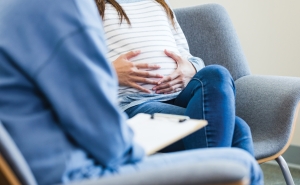Analysis of U.S. Census Survey Data Reveals Uptick in Anxiety and Depression Among Women in States with Trigger Laws Post-Dobbs Abortion Decision
June 2022 Supreme Court ruling overturned federal right to abortion, triggering laws in 13 states that banned or restricted abortion

An analysis of national survey data conducted by researchers at the Johns Hopkins Bloomberg School of Public Health found a small but statistically significant increase in self-reported anxiety and depression symptoms among respondents in states that banned abortion after the U.S. Supreme Court’s reversal of Roe v. Wade in June 2022 compared to respondents in states that did not enact bans.
The Dobbs decision, handed down on June 24, 2022, overturned the 1973 Roe v. Wade decision that made abortion a constitutionally protected right and returned the question of abortion regulation to individual states. The Dobbs decision triggered laws banning abortion that had been passed earlier in 13 states in anticipation of Roe being overturned.
The analysis found that the increase in self-reports of anxiety and depression in the six months following the Dobbs decision announcement was most pronounced among females ages 18 to 45. The increase among males in that age range during this time period was small and not statistically significant. While scores increased in trigger states, the authors note that, on average, the scores remained in the mild range.
The study was published online January 23 in JAMA.
“These findings suggest that changes in abortion policy can impact mental health at the population level,” says study senior author Matthew Eisenberg, PhD, an associate professor in the Bloomberg School’s Department of Health Policy and Management, and director of the Center for Mental Health and Addiction Policy, also at the Bloomberg School. “Policymakers should, of course, be aware of the first-order impacts of policies, but studies such as this suggest that they should also consider downstream policy effects on mental health, even when a policy is not specifically targeting mental health.”
The study’s first author was Benjamin Thornburg, a PhD candidate in the same department.
For their analysis, the researchers used de-identified data from the Household Pulse Survey, an online survey the U.S. Census Bureau started conducting in April 2020, early in the COVID-19 pandemic. The survey gathers data from respondents ages 18 and up in U.S. households approximately every two weeks to provide snapshots of households’ health and socioeconomic situations.
The survey includes the Patient Health Questionnaire-4 (PHQ-4), a four-question screening tool often used in primary care settings to assess anxiety and depression. PHQ-4 scores range from zero to 12. A score of zero to 2 indicates no symptoms of depression/anxiety, scores from 3 to 5 are considered mild, and scores of 6 to 12 are considered moderate to severe. A score above 5 suggests a high probability of depression or anxiety, meriting further evaluation and/or treatment. The study covered 13 waves of data from the survey’s public use files, spanning December 29, 2021, to January 19, 2023.
There were 718,753 respondents during the study period—159,854 in trigger states and 558,899 in non-trigger states. For their study, the researchers analyzed responses from females ages 18 to 45 years (153,108) and from males ages 18 to 45 (102,581). (Forty-five is the age researchers often use to compute lifetime abortion incidence. The estimates were representative of the general population.)
The researchers calculated average PHQ-4 scores across the survey sample during a “baseline” interval from December 29, 2021, to May 2, 2022, the date a draft of the Dobbs decision was leaked to the media, and an “opinion” interval following June 24, 2022, the date the Supreme Court publicly announced its Dobbs decision.
The researchers found that PHQ-4 anxiety/depression scores were 8.5 percent higher for all ages in trigger states than in non-trigger states in the six months after the opinion (3.51 versus 3.81). In non-trigger states, scores for all ages increased 5.4 percent after the opinion (3.31 versus 3.49). The increase among women ages 18 to 45 in trigger states was 3.03 percent (4.62 vs. 4.76), while scores in non-trigger stages decreased by 1.75 percent (4.57 vs. 4.49).
The 13 states that had trigger laws in place at the time the Dobbs decision was announced were Arkansas, Idaho, Kentucky, Louisiana, Mississippi, Missouri, North Dakota, Oklahoma, South Dakota, Tennessee, Texas, Utah, and Wyoming.
The authors note that the study has several limitations. Most notably, the data were pooled cross-sections of different individuals over time, not a panel of the same sample repeatedly measured, which makes it more difficult to adjust for individual characteristics. They note that large sample size, population representativeness, and state-level analyses help to ameliorate this concern.
The researchers now plan to examine other potential impacts of Dobbs, for example, on the supply of new physicians in certain specialties in states where abortion is now unlawful or heavily restricted.
The authors note that their findings build on emerging literature. “Prior to Dobbs, research established that denial to abortion access was associated with adverse outcomes, including symptoms of anxiety,” says Thornburg. “Emerging research has suggested that a similar trend may emerge at the national level as states enact more restrictive abortion policies following Dobbs, which is precisely what our study reveals.”
“Anxiety and Depression Symptoms After the Dobbs Abortion Rights Decision” was co-authored by Benjamin Thornburg, Alene Kennedy-Hendricks, Joanne Rosen, and Matthew Eisenberg.
Support for the research was provided by the Agency for Healthcare Research and Quality (T32HS000029) and the National Institute of Mental Health (T32MH109436).
# # #
Media contacts: Lindsey Culli lculli1@jh.edu and Kris Henry khenry39@jhu.edu




